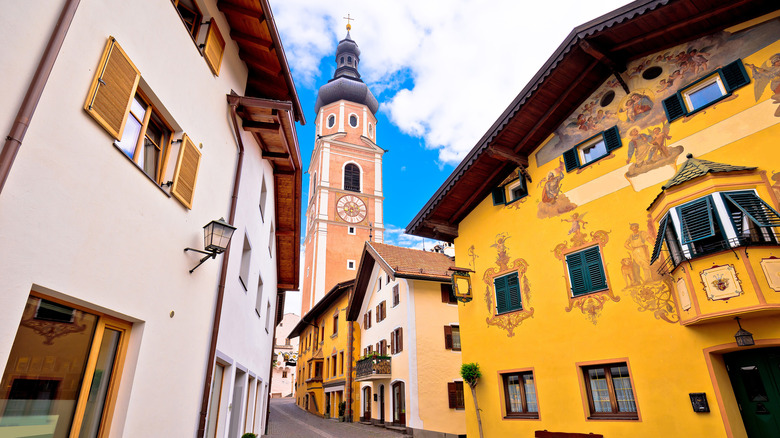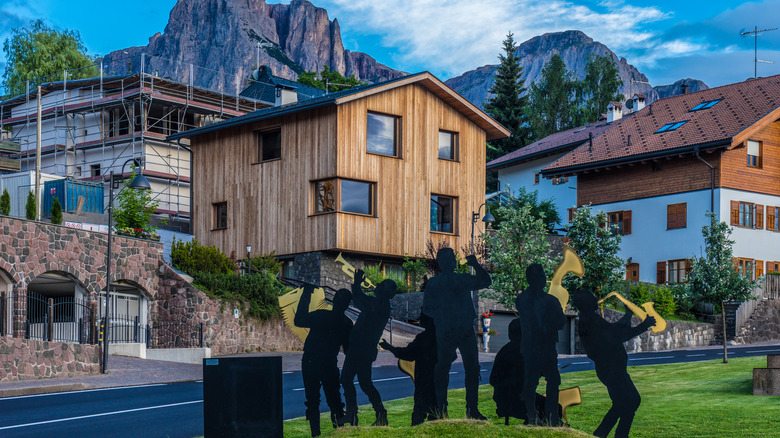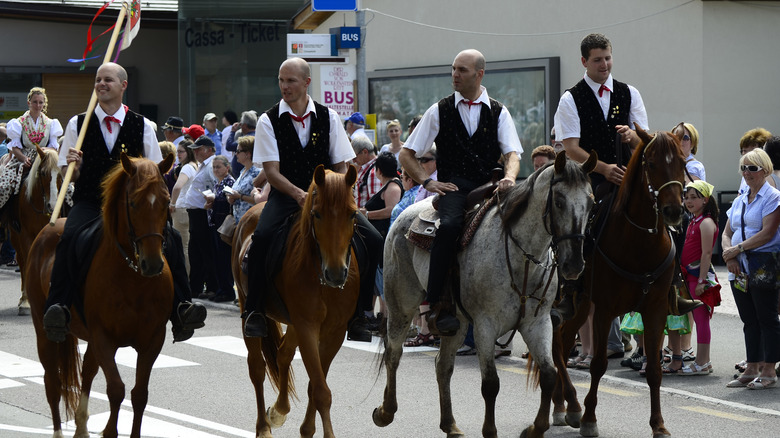One Of Rick Steves' Favorite Hidden Gems In Italy Is This Picturesque Mountain Town
One of the things you notice when traveling around Europe is how one country's culture doesn't stop at the border, only to be replaced by another on the other side. Languages and mutual influences often extend either side of the demarcation, and that's something you really notice in the mountainous South Tyrol region of northern Italy. There, near the border with Austria, is one of travel writer and broadcaster Rick Steves' favorite hidden gems: Kastelruth, or Castelrotto in Italian.
The autonomous province of South Tyrol was once part of the Austro-Hungarian Empire until it was annexed by Italy just after World War I, and Kastelruth's Germanic roots are still evident today — only around 5% of the town's residents speaking Italian as a first language. The picture-postcard view of the skyline might make you think you're in Germany or Austria; with the imposing crags of the Dolomites behind, the striking onion dome of the parish church tower is more reminiscent of Austrian and Bavarian places of worship than the cathedrals and basilicas found in Italian bucket list cities like Naples, Florence, or Rome. The influence is also felt on the street, where many signs are in both German and Italian, and Steves suggests that you're just as likely to find "Tirolean clichés" like bratwurst and sauerkraut on the menu as pizza and pasta. With its Alpine vibe, Kastelruth is a charming getaway from the usual must-see sights of Italy and a great base for exploring the Dolomites.
Things to do in and around Kastelruth
Kastelruth is a small town of almost 7,000 people, but it has plenty to keep visitors occupied. The picturesque streets make for a pleasant meander, especially with the peal of church bells in the background. The landmark free-standing tower of Saints Peter and Paul, affectionately known as the "cathedral on the mountains," has nine bells that ring out on the hour and summon worshippers to Mass on Sundays. As Rick Steves notes on his website, they're a big part of the Kastelruth experience.
To learn more about the town and its proud rural history and folk traditions, it's worth checking out the Farmers' Museum and the Museum of Traditional Costumes. The latter has been made famous internationally by Kastelruther Spatzen, a folk music ensemble that began big in the '80s and has won numerous awards — or "ABBA of the Alps," per Steves. Their "oompah" style of schlager tunes is still very popular with older German-speaking audiences, and the town has a Kastelruther Spatzen Museum dedicated to the band.
Outside of town, Kastelruth's proximity to the Dolomites makes it a perfect place for outdoor activities throughout the year. There are a couple of ski resorts in the area, and several hiking trails are great for exploring the beautiful area in the warmer weather. Spring is arguably the best time to visit the Italian Alps, especially in nearby Seiser Alm (Alpe di Suisi), where you can stroll through gorgeous meadows surrounded by dramatic peaks.
Festivals and events in Kastelruth
It's always fun to visit a destination when local cultural events are taking place, and Kastelruth has a busy schedule throughout the year. Fans of equestrian sports might enjoy the Oswald von Wolkenstein Riding Tournament, where teams from across the Tyrol compete in a variety of challenges. The event attracts spectators from all over the region, and there is traditional music and other activities.
If you want to see what all the fuss is about with Kastelruther Spatzen, the town's most famous musical export, book your visit for the middle of June when the open-air Kastelruther Spatzenfest takes place. Thousands of people arrive for the two-day event to revel in the music, drink beer, and await the star attraction — a performance from the current line-up of the band.
Foodies have two events in particular to look out for. During July and August, there is Knödelfest — the Dumpling Festival. Taking place in the main square, local cooks prepare a wide variety of the Tyrolean speciality for visitors to enjoy, from traditional bacon dumplings to sweeter fruit options. In autumn, the annual Törggelen festival, where a hearty feast of sausages, sauerkraut, dumplings, bacon, and other local delicacies is accompanied by the harvest's new wine. As evening falls, the traditional dessert of fire-roasted chestnuts with butter is a toasty treat, especially when washed down with another drop of vino.


